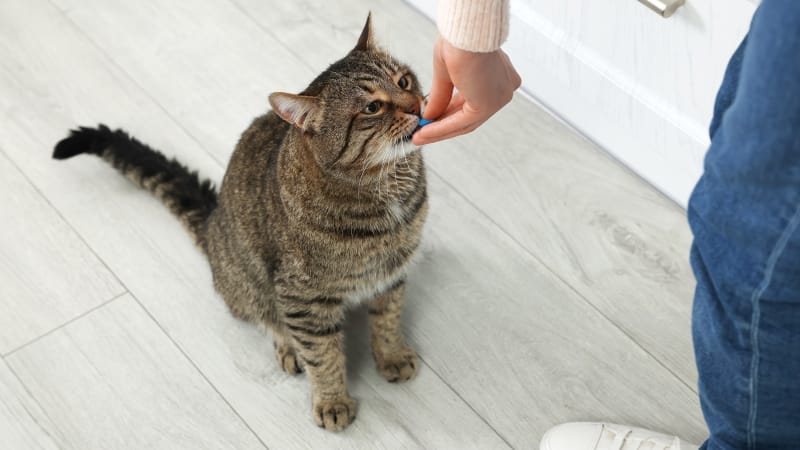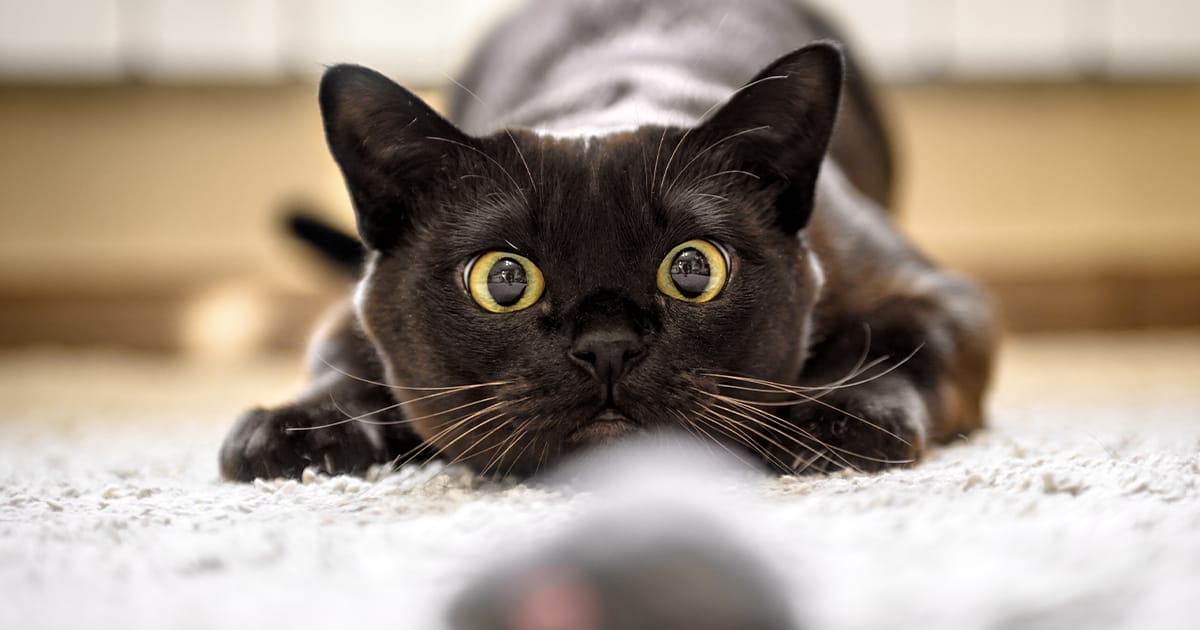
Cushing’s Disease in Cats: Signs and Treatment
Cushing’s disease, while rare in cats, occurs when the body produces too much cortisol, Learn the signs, treatment, and prognosis.
Cushing’s disease, also known as Cushing’s syndrome or hyperadrenocorticism, is a rare condition in cats that occurs when their body creates an excessive amount of the hormone cortisol. This hormonal imbalance can have detrimental effects on your feline companion’s organs and overall health. Read on to learn more about Cushing’s disease in cats, including the causes, signs, treatment options, and the prognosis for your pet.
What Causes Cushing’s Disease in Cats?
Cortisol, a hormone naturally produced in the body, plays a crucial role in helping cats manage stress. However, when the body produces an excessive amount of cortisol, a condition known as hyperadrenocorticism, or Cushing’s disease/syndrome, can develop.
Tumors are an abnormal overgrowth of tissue that can be malignant (cancerous) or benign and tumors in hormonal tissues can lead to hormone imbalances. When this develops in the adrenal glands (located near the kidneys or pituitary glands at the base of the brain), the resulting condition is known as primary hyperadrenocorticism, which is a form of Cushing’s disease.
Another potential cause of Cushing’s disease in cats is the prolonged use of steroid medications, such as prednisolone and dexamethasone. Steroid injections and even sometimes topical ointments can also contribute to iatrogenic Cushing’s. These medications are commonly prescribed to treat allergies and inflammation caused by various health conditions. Similarly, the use of progesterone-type drugs to control reproductive cycling in female cats can also contribute to the development of Cushing’s disease. While these medications are effective for their intended purposes, long-term use can inadvertently result in an overexposure of the body to cortisol-like effects. This medication-induced form of Cushing’s disease in cats is known as iatrogenic Cushing’s.

Clinical Signs of Cushing’s Disease
While Cushing’s disease can affect felines of all ages, it is most diagnosed in middle-aged to senior cats, who often have diabetes as well, meaning the signs of diabetes can indicate the presence of Cushing’s disease. Additionally, about 75% of cats diagnosed with Cushing’s are female. Cats with Cushing’s disease may exhibit signs that resemble natural changes occurring with aging, such as:
- Thinning of the skin and hair loss: One common sign of Cushing’s disease in cats is extremely thin and fragile skin that easily breaks, even with gentle petting. This can have an impact on the cat’s overall appearance and make them more prone to developing various skin conditions.
- Curling ear tips: A change in the structure of a cat’s ears, such as curling or folding ear tips, can be an indication of Cushing’s disease in cats.
- Increased thirst and urination: The increased production of cortisol in cats with Cushing’s disease affects the body’s water balance. As a result, these cats may exhibit increased thirst and urination, leading to larger volumes of urine being produced. Additionally, cats with Cushing’s disease may be more prone to recurrent urinary tract infections (UTIs).
- Increased appetite: Cats with Cushing’s disease often experience an increased appetite because of elevated cortisol levels, which stimulate the body’s hunger response. This can lead to weight gain or difficulty in losing weight, even if the cat is not consuming more food than usual.
- Weight gain or difficulty losing weight: Weight gain in cats with Cushing’s disease is commonly associated with the increased appetite and fluid retention that accompanies the condition. These cats may also exhibit a pot-bellied appearance and struggle to lose weight, even with a restricted diet and regular exercise.
- Lethargy and muscle weakness: The increased levels of cortisol in cats with Cushing’s disease can lead to lethargy and weakness due to the body’s decreased energy metabolism. As a result, affected cats may tire easily during exercise or play and have difficulty getting up or down, which can significantly impact their quality of life.
- Poorly controlled diabetes: A significant 80% of cats diagnosed with Cushing’s disease also have diabetes. Often, these cats receive treatment solely for diabetes since it is a more common condition and easier to identify than Cushing’s. However, if a cat’s diabetes remains uncontrolled despite treatment, it is worth considering Cushing’s disease as a potential underlying cause. This is because the cortisol produced in excess by Cushing’s can disrupt the effectiveness of insulin.
Cats that have Cushing’s syndrome are also at higher risk for developing:
- Diabetes
- Blood clots – mainly involving the lungs, legs, and brain
- Infections of the lungs, skin, bladder, and kidneys
- Inflammation of the pancreas (pancreatitis)
- High blood pressure (systemic hypertension)
Not all cats with Cushing’s disease will display each of these signs, and some felines may only have mild symptoms. If you suspect that your cat may have Cushing’s disease, it is essential to consult a veterinarian for proper diagnosis and treatment.
Diagnosing Cushing’s Disease in Cats
Diagnosing Cushing’s in cats involves a comprehensive evaluation by your veterinarian. The diagnostic process typically begins with a thorough physical examination, during which your veterinarian will assess your pet’s overall health, body condition, and any visible signs of the disease. Your veterinarian will also inquire about your cat’s medical history, including any medications they’re taking, and any signs you have observed.
Based on the findings of the physical examination and medical history, your veterinarian may recommend a series of diagnostic tests to confirm the presence of Cushing’s disease and determine the underlying cause. These tests may include:
- Blood tests: Routine blood tests may lead a veterinarian to suspect Cushing’s disease. Special hormonal blood levels would then need to be ordered to further investigate the possibility of Cushing’s disease. Some of the specialized blood tests include the ACTH stimulation test or the low-dose dexamethasone test which help your veterinarian better understand the functionality of the adrenal and pituitary gland.
- Imaging tests: In some cases, imaging tests like abdominal ultrasound, CT, or magnetic resonance imaging (MRI) scan may be suggested to detect any tumors or abnormalities in the adrenal glands or pituitary gland. These tests are valuable in identifying the underlying cause of Cushing’s disease and aiding in the selection of the most suitable treatment approach.
Based on your cat’s condition and response to the initial diagnostic tests, your veterinarian may suggest further tests or procedures. This is done to ensure an accurate diagnosis, which is important for developing the most suitable treatment plan and achieving the best possible outcome for your pet.

Is Treatment Critical with Cushing’s Disease?
Cushing’s disease can have serious consequences for your pet’s health, potentially leading to severe complications or even death if not addressed. It’s important to note that even if your cat doesn’t show any signs, the disease can still harm internal organs like the heart, liver, and kidneys. Detecting and treating Cushing’s disease early on can help slow its progression and enhance your cat’s overall wellbeing and quality of life.
The primary goal of treatment for Cushing’s disease is to reduce the levels of cortisol in the body and manage the signs of the disease. Treatment options may include medication, surgery, radiation, or a combination of these approaches.
How is Cushing’s Disease Treated?
The treatment options for Cushing’s differ depending on whether your pet has the syndrome due to a problem with their pituitary or adrenal glands.
Treatment options can include:
- Medication: While there are several medications available to suppress cortisol production in dogs with Cushing’s disease, the options for cats are more limited. Trilostane, which works by inhibiting cortisol production in the adrenal glands, has been shown to be the most effective treatment for cats with Cushing’s disease. However, it’s important to note that it may take some time before you see noticeable improvements.
- Surgery: If your cat is diagnosed with adrenal-dependent Cushing’s disease, your veterinarian may consider surgery as a treatment option. The primary objective of surgery is to remove the tumor responsible for the excessive cortisol production and restore normal cortisol levels. If the entire tumor is successfully removed and determined to be non-malignant, there is a high likelihood that your pet will experience a return to normal health.
- Radiation therapy: In some cases, if a pituitary tumor is large and causes neurological symptoms, a CT scan and radiation therapy may be considered as treatment options. Radiation therapy can help shrink the tumor and reduce cortisol production. It may be used in combination with surgery or medication to effectively manage the disease.
If your pet has developed iatrogenic Cushing’s disease because of receiving oral or injectable steroids for medical reasons, the primary treatment approach is to gradually discontinue the use of steroids. It’s important to note that discontinuing steroid therapy may lead to the recurrence of the original condition that was being treated, and in some cases, hormone replacement therapy may be necessary to support the function of the adrenal glands.

What to Expect After Treatment Begins
As a pet owner, it’s important to stay vigilant and monitor your cat’s condition when managing Cushing’s disease, regardless of the treatment approach. Regular physical examinations, blood tests, and urine tests are essential to evaluate the effectiveness of the treatment and keep track of your cat’s well–being.
Although there is no cure for Cushing’s disease, if your pet is prescribed lifelong medication, you should start seeing improvements in their symptoms within a few weeks. Your veterinarian will closely monitor your pet’s progress to ensure that the medication is working as intended and make any necessary adjustments to the dosage.
To determine the correct medication dosage for your cat, your veterinarian might perform an ACTH Stimulation Test. This test evaluates cortisol levels to help verify that your cat’s medicine isn’t leading to excessive cortisol hormone suppression.
Typically, the ACTH Stimulation Test is conducted within two weeks after starting therapy and repeated every few weeks until the right medication dosage is determined for your cat’s specific requirements. Once the correct dosage is established, your cat will typically be evaluated every 3-4 months to ensure ongoing effectiveness of the treatment. This monitoring approach allows your veterinarian to fine-tune the medication dosage and provide the best care for your cat’s individual needs.
If you notice any of the following signs in your cat after starting treatment for Cushing’s disease, it is important to contact your veterinarian:
- Changes in appetite, such as eating slower or not finishing meals
- Vomiting or diarrhea
- Decreased activity and increased sleeping
These changes in behavior could indicate a need for adjustment in the treatment plan or dosage. It is crucial to report any such changes promptly to your veterinarian so that they can assess the situation and provide appropriate guidance. In addition, if your cat has diabetes, keep in mind their insulin needs can change as their cortisol levels are managed. Your veterinarian may need to reassess your cat’s diabetes management care.
Prognosis for Feline Cushing’s Disease
The prognosis for cats with Cushing’s disease can vary depending on several factors, including the severity of the disease, the overall health of the cat, and the chosen treatment approach. Cats with mild Cushing’s disease generally have a more positive prognosis compared to those with moderate or severe cases.
Additionally, the underlying cause of Cushing’s disease is a factor in the prognosis. Cats with pituitary-dependent Cushing’s disease typically have a more favorable prognosis than those with adrenal-dependent Cushing’s disease.
Your veterinarian can provide you with more specific information about your cat’s prognosis based on their individual circumstances. However, in general, most cats with Cushing’s disease can experience a significant improvement in their quality of life with treatment.
Treatment for Cushing’s disease aims to control the clinical signs associated with the condition, such as increased thirst, urination, appetite, and weight gain. It can also help improve your cat’s energy level, skin and coat health, and overall wellbeing. It’s important to note that treatment for Cushing’s disease is typically lifelong. This means that you will need to work closely with your veterinarian to monitor your cat’s condition and ensure that the disease is well-controlled. With proper management and regular check-ups, your cat can live a long and healthy life.
If you suspect your cat may have Cushing’s disease, it’s important to contact your family veterinarian for an accurate diagnosis and a tailored treatment plan. They may recommend a specialist in Cushing’s disease, such as those at MedVet, who possess expertise in this condition.
To find the MedVet nearest to you, visit https://www.medvet.com/locations/.
FAQs
What causes Cushing’s disease in cats?
What are the signs of Cushing’s disease in cats?
How is Cushing’s disease in cats treated?
Contents



